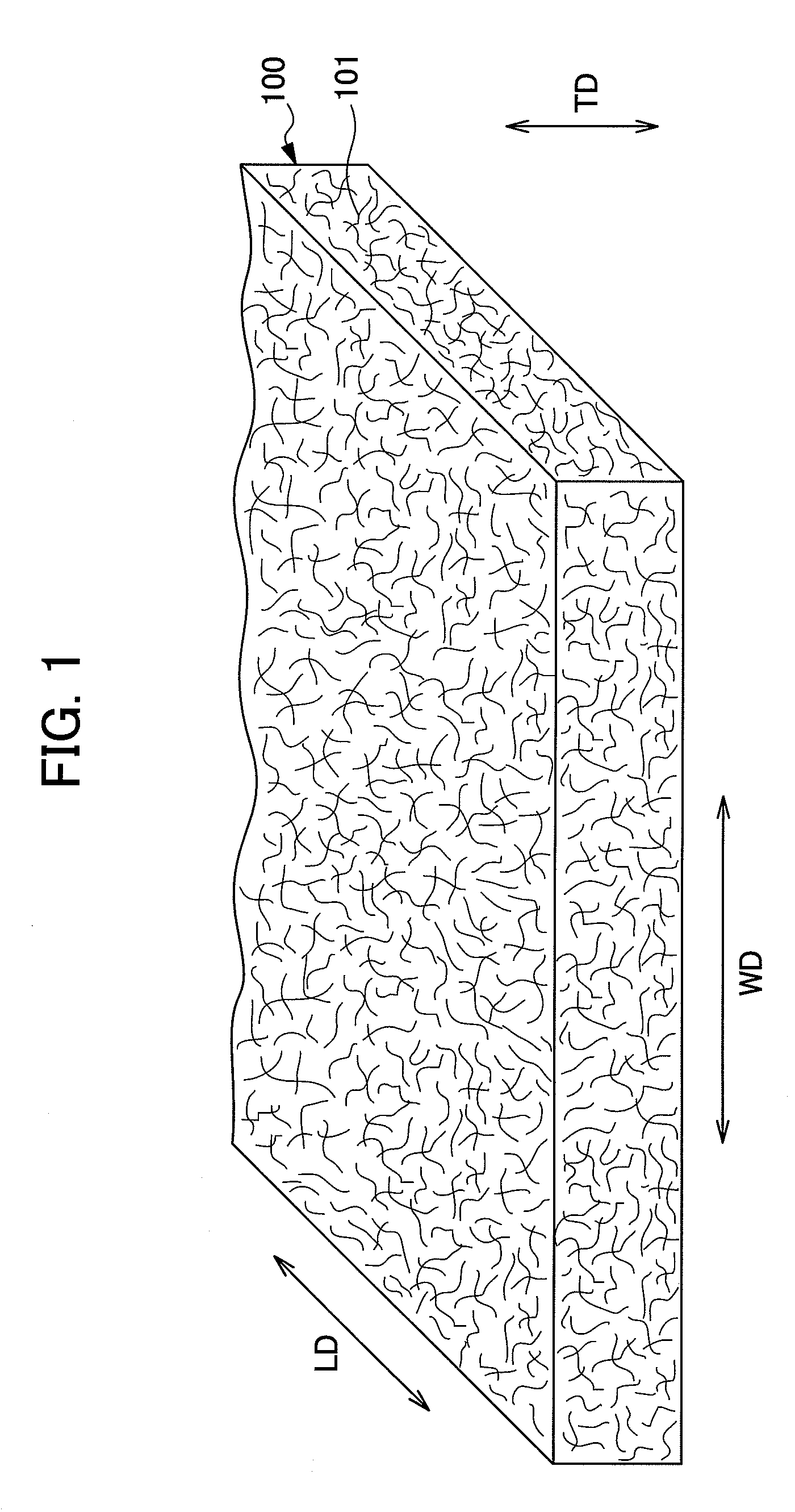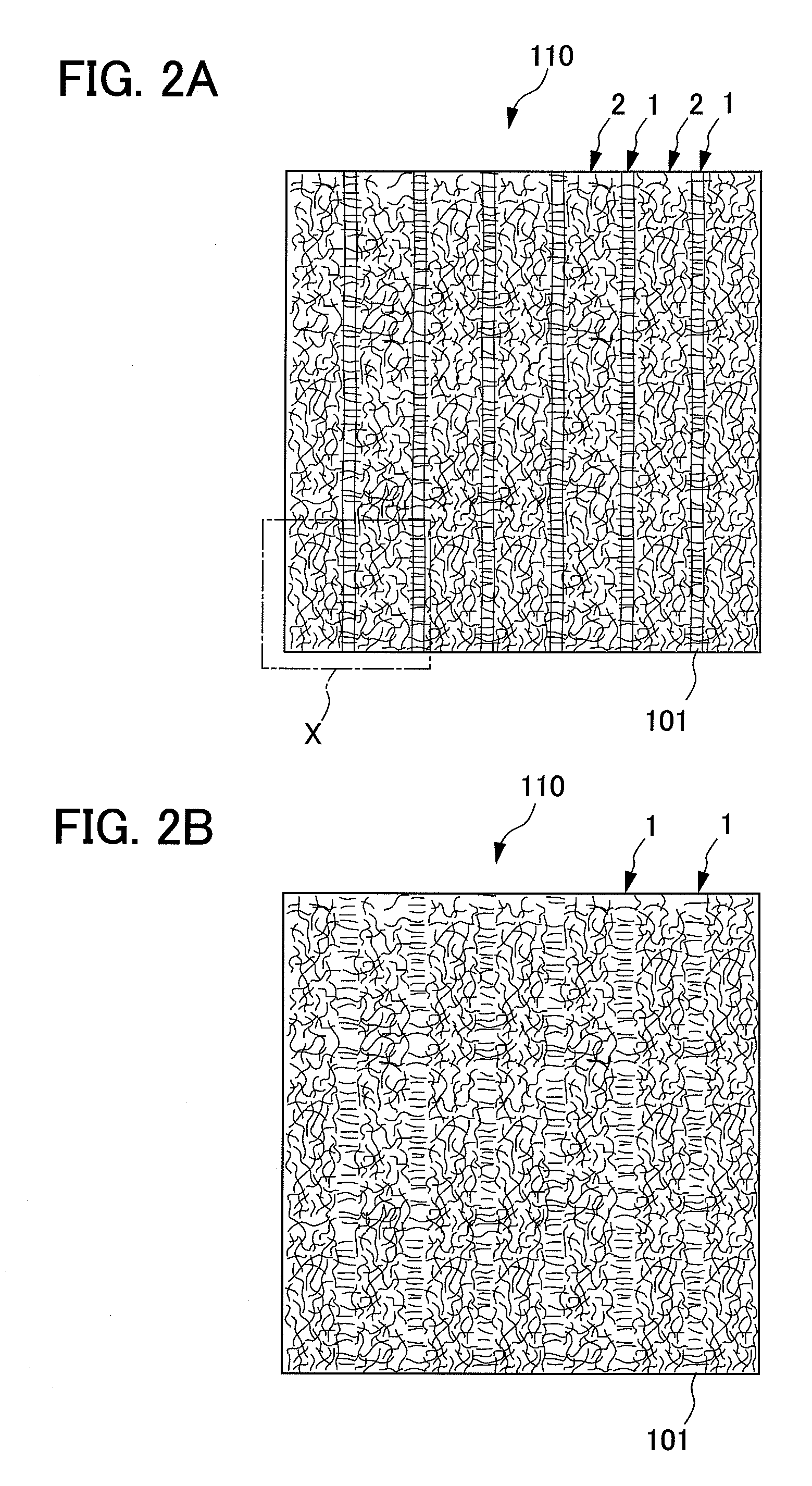Nonwoven fabric
a non-woven fabric and fabric technology, applied in the field of non-woven fabrics, can solve problems such as shrinkag
- Summary
- Abstract
- Description
- Claims
- Application Information
AI Technical Summary
Benefits of technology
Problems solved by technology
Method used
Image
Examples
first embodiment
1-2. First Embodiment
[0049]A nonwoven fabric according to a first embodiment of the present invention is described below while referring to FIGS. 2 to 5.
1-2-1. Shapes
[0050]As shown in FIGS. 2A, 2B, and 3, a nonwoven fabric 110 according to this embodiment is a nonwoven fabric which is formed so that a plurality of grooves 1 or first regions is formed substantially parallel at substantially equal intervals in a longitudinal direction (LD) on one side of the nonwoven fabric 110. In addition, a plurality of convex portions 2, which is constituted with second regions and third regions, is formed between the plurality of respective grooves 1 formed at substantially equal intervals. The convex portions 2 are formed in parallel at substantially equal intervals as with the grooves 1.
[0051]In the case of this embodiment, the grooves 1 are formed in parallel at substantially equal intervals, but are not limited thereto. For example, the grooves 1 may be formed at different intervals; or may b...
second embodiment
2-1. Second Embodiment
2-1-1 Shape
[0108]As illustrated in FIG. 10, a nonwoven fabric 114 according to this embodiment is a nonwoven fabric of which both surfaces are substantially flat. In addition, it is a nonwoven fabric on which regions with different fiber orientations and the like in predetermined regions are formed. Differences from the first embodiment are mainly described below.
2-1-2. Fiber Orientation
[0109]As illustrated in FIG. 10, a plurality of regions with different content ratios of longitudinally orientated fibers is formed in the nonwoven fabric 114. In the nonwoven fabric 114, longitudinally orientated portions 13 or second regions with the highest content ratio of longitudinally orientated fibers, central portions 12 or third regions with a lower content ratio of longitudinally orientated fibers than those in the longitudinally orientated portions 13, and laterally orientated portions 11 or first regions with the lowest content ratio of longitudinally orientated fib...
third embodiment
2-2. Third Embodiment
[0122]A nonwoven fabric according to the third embodiment of the present invention is described below while referring to FIGS. 11 and 12.
2-2-1. Nonwoven Fabric
[0123]As illustrated in FIGS. 11 and 12, a nonwoven fabric 116 according to this embodiment is different from the first embodiment in that the entire nonwoven fabric 116 has alternating undulations in a longitudinal direction (LD). The differences are mainly described below.
[0124]The nonwoven fabric 116 according to this embodiment is formed so that the entire nonwoven fabric 116 has wavy undulations substantially orthogonal to the direction in which grooves 1 and convex portions 2 extend.
2-2-2. Manufacturing Method
[0125]The nonwoven fabric 116 according to this embodiment may be formed in the same manner as the first embodiment; however, the shape of a netted supporting member 260 or a breathable supporting member 200 differs. The netted supporting member 260 of this embodiment is formed so that a plurali...
PUM
 Login to View More
Login to View More Abstract
Description
Claims
Application Information
 Login to View More
Login to View More - R&D
- Intellectual Property
- Life Sciences
- Materials
- Tech Scout
- Unparalleled Data Quality
- Higher Quality Content
- 60% Fewer Hallucinations
Browse by: Latest US Patents, China's latest patents, Technical Efficacy Thesaurus, Application Domain, Technology Topic, Popular Technical Reports.
© 2025 PatSnap. All rights reserved.Legal|Privacy policy|Modern Slavery Act Transparency Statement|Sitemap|About US| Contact US: help@patsnap.com



